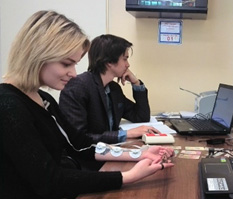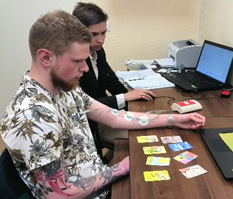Cardiometric Correlates of Using Coaching Associative Cards When Working with Human Ego States
Abstract
The article presents experimental evidence of the hypothesis that the theoretical construct ego state, widely used in coaching, in addition to its psychological content, reflects the physiological mobilization of a person to a certain reaction type. Such mobilization is manifested in how the human cardiovascular system works. Experimental evidence is given that the theoretical construct ego state really captures completely definite and meaningfully different psychophysiological states of a person. Also shown is that transitions from such an ego state to another one are indeed accompanied by significant changes in heart rate variability that was estimated with the help of the Baevsky Stress Index (SI). Also provided is experimental data confirming the validity of using the Baevsky (SI to evaluate the effectiveness of various options for working with coaching associative cards (CACs).
Introduction
For more than half a century, coaches, psychologists, and psychotherapists have been actively using a psychological concept of the ego state of a person, which means a combination of feelings, thoughts, and actions connected with each other as a way of manifesting our personality at a certain moment (Berne, 2010; Ognev, et al., 2019; Shmelev, 2015).
In transactional analysis, created by Berne (2006), such ego states as the Inner Child, the Inner Adult, and the Inner Parent (Berne, 2006) are distinguished as basic ego states. Each of these ego states has the quality that can be designated as subjectivity, which means “the cause of oneself” (Petrovskiy, 2010), which has its own phenomenological content and integrity of experience in a specific period of time. The Inner Child, according to transactional analysis, is a combination of thoughts, feelings, and behaviors characteristic of any experience at an earlier age. The Inner Adult is a set of thoughts, feelings, and behaviors related to the current situation with the reality of “here and now.” This stage focuses on a pragmatic assessment of what is happening as well as a rational assessment of the causes and possible consequences of certain events. The Inner Parent is a combination of thoughts, feelings, and behaviors inherent in one of the parents. Parental figure means any person who played a significant role in shaping the personality of that person. Parent formation occurs throughout life. In everyday life, the Inner Parent manifests itself in moral and ethical attitudes to your and others’ behavior. Both the Inner Child and the Inner Parent regress under stress. The higher the level of stress, the higher the level of manifestation of the Inner Child and the Inner Parent. The level of regression under stress shows the stability and strength of the self. This raises the question as to whether this is really the case: Are there physiological correlates of ego states?
Despite the years-long practice of using these theoretical concepts, there is practically no experimental confirmation that these ego states really differ from each other in the physiological reactions associated with them. The existence of such reactions follows from the proposition that its creators included the mobilization readiness of a person for a certain type of reaction in the theoretical concept of ego state. Initially, such a mobilization should be manifested in how the human cardiovascular system works. If the theoretical concept of ego state is not just a popular metaphor, and if it is used to register quite meaningfully different psychophysiological states of a person, then transitions from one ego state to another should be accompanied by significant changes in the work of the human body, and above all — of the heart. On the basis of the results described in our earlier studies (Ognev et al., 2019), the assumption is that such changes can be recorded by assessing heart rate variability using the Baevsky SI.
Study Methods
To test the hypothesis presented, the authors carried out a series of experiments in which the key transactional ego states were modeled with the help of metaphorical associative cards. At the same time, the psychophysiological reactions corresponding to these states were recorded with the help of the computer hemodynamic recorders Cardiocode. Meanwhile, the authors took into account the results of previous experimental studies, which showed that an increased Baevsky SI, when compared to average values, can be considered as a sign of an asthenic reaction to a stimulus, and the lower Baevsky SI value can be considered a sign of an asthenic reaction to a stimulus. We also believe that Baevsky SI indicators are a more effective indicator of the nature of participants’ emotional reactions than changes in their heart rates (Ognev et al., 2019).
Taking into account the pictorial turn, which became a clearly identified trend at the end of the 20th century and is constantly accelerating (Alexander, 2008; Dors & Vogel, 2014; Mitchell, 1994), metaphorical associative cards were chosen as a stimulus material to actualize the ego states described above. As shown in numerous scientific publications, the images used in metaphorical cards help the therapist to actualize certain psychophysiological conditions of the patient, which can be used as “targets” for psycho-corrective intervention (Buravtsova, 2018).
For stimulus material in the experiments, the authors used the standard set of coaching associative cards (CACs) created by Shmelev (2015). This choice was made because of productive use of CACs by consultants and coaches in different areas.
The study involved 126 respondents (average age of 20.5 years, the standard deviation from which amounted to a total of 5.4 years in the sample). The consistent algorithm for the work of all respondents included the following tasks. Initially, respondents were asked to select metaphorical associative cards that they associated with the negative Inner Adult, Inner Parent, and Inner Child, as well as with the positive Inner Adult, Inner Parent, and Inner Child.
Then all respondents spent 15 seconds alternately fixing their attention on the cards that they associated with each of the ego states listed above. The final task for the respondents was to select all the metaphorical associative cards that they associated with positive ego states and then focus their attention on all such cards for 15 seconds at a time.
When the participants were performing these tasks, their cardiograms were recorded using computer hemodynamic recorders Cardiocode. This stage is shown in the photographs of participants performing tasks while their cardiograms are recorded.


Further, using the algorithms embedded in the software of these recorders, the authors calculated the Baevsky SI for each participant. Processing of all received data was carried out using the statistical package Stadia 8.0.
Discussion of Results
The obtained statistical patterns in determining the Baevsky SI for various ego states of the respondents are presented in Table 1.
Table 1. The Main Statistical Parameters of SI for Various Ego States of Respondents
| Ego States | Arithmetic Mean Value | Standard Deviation | Median value | Skewness | Excess Kurtosis |
|---|---|---|---|---|---|
| 1 | 341.4 | 196 | 288 | 0.99 | 3.317 |
| 2 | 257.5 | 214.3 | 206 | 3.195 | 16.04 |
| 3 | 335.3 | 247.8 | 279.5 | 2.462 | 12.26 |
| 4 | 254.8 | 216.3 | 200.5 | 2.681 | 11.46 |
| 5 | 334.1 | 340.4 | 251 | 0.169 | 0.56 |
| 6 | 258.1 | 185.2 | 168.9 | 0.173 | 6.8 |
| 7 | 210.5 | 208.4 | 185.2 | 2.984 | 15.35 |
The first column of this and all the following tables shows the numbers that indicate the following ego states: 1, 3, 5 — the negative Inner Adult, Inner Parent, and Inner Child that were successively triggered; 2, 4, 6 — the positive Inner Adult, Inner Parent, and Inner Child that were successively triggered; 7 — the integrative ego state, caused by the respondents’ simultaneous concentration on the stimuli with which they designated as the positive conditions of the Inner Adult, Inner Parent, and Inner Child.
The static significance of differences in average values was confirmed by the χ (chi-square) criterion, which was evaluated with the help of the statistical package Stadia 8.0.
The resulting distributions differed from the Gauss-Laplace distribution. Therefore, to identify correlation relationships, the authors used Spearman’s rho and Kendall’s tau coefficients. Since the nature of the identified relationships for each of these coefficients and the factor structure revealed for each of them are similar, in the following tables only data for Spearman’s rho coefficient are given, in view of its greater universality.
The tables below show the results of various options for optimizing the factor structure of the data using Spearman’s rho coefficient. Table 2 shows the parameters of the factor structure after using the Varimax Rotation, with which we sought to minimize the number of variables with high loads on each factor. Table 3 presents the data obtained after applying the Quartimax Rotation, with which we tried to minimize the number of factors that are required for a meaningful interpretation of each variable used. Table 4 shows the results of the Equimax Rotation, which was used to simultaneously minimize the number of variables with large factor loads and the number of factors explaining them. The authors also performed the Оblique Rotation, with which we sought to minimize the number of factors without ensuring their complete orthogonality. The result was that the factor structure of correlations after the Оblique Rotation exactly corresponded to the structure obtained after the Varimax Rotation. While optimizing the factor structure of the revealed correlation relationships, we analyzed the options, which included from three factors (covered up to 50% of the variance and was associated with large losses of information) to seven factors (covered more than 90% of the variance and was characterized by the presence of a significant number of uninformative relationships). Optimal was the optimization of the factor structure of the revealed correlation relationships, which included four factors and covered more than 80% of the variance. The data for this optimization option are presented in Tables 2–4.
Table 2. Factor Structure of Correlations After the Varimax Rotation
| Ego States | Factor Numbers | |||
|---|---|---|---|---|
| 1 | 2 | 3 | 4 | |
| 1 | 0.8852 | |||
| 2 | 0.5996 | 0.59 | ||
| 3 | 0.9457 | |||
| 4 | 0.4961 | 0.3833 | 0.5888 | |
| 5 | 0.9013 | |||
| 6 | 0.6684 | 0.3228 | ||
| 7 | 0.8814 | |||
Table 3. Factor Structure of Correlations After the Quartimax Rotation
| Ego States | Factor Numbers | |||
|---|---|---|---|---|
| 1 | 2 | 3 | 4 | |
| 1 | 0.853 | |||
| 2 | 0.6916 | 0.4843 | ||
| 3 | 0.9276 | |||
| 4 | 0.6208 | 0.3407 | 0.481 | |
| 5 | 0.8514 | |||
| 6 | 0.763 | |||
| 7 | 0.8797 | |||
Table 4. Factor Structure of Correlations After the Equimax Rotation
| Ego States | Factor Numbers | |||
|---|---|---|---|---|
| 1 | 2 | 3 | 4 | |
| 1 | 0.8775 | |||
| 2 | 0.6383 | 0.5528 | ||
| 3 | 0.9387 | |||
| 4 | 0.543 | 0.3646 | 0.5581 | |
| 5 | 0.8897 | |||
| 6 | 0.7072 | 0.2811 | ||
| 7 | 0.877 | |||
As seen from the data presented, SI indicators for the positive ego states are part of some factors, and SI indicators for the negative ego states are part of other factors. Moreover, these regularity and factor structures are retained for all the rotation options used. The structures, as well as the statistically significant differences in average SI indicators, also demonstrates a substantial generality of the positive ego states, which differs significantly from a substantial generality of SI indicators for the negative ego states.
The most powerful factors in all variants of rotation included SI indicators for all positive ego states, when they were successively triggered, and the SI indicator, which was obtained when respondents worked with all three positive ego states. In this regard, we should recall that in transactional analysis, the therapy completion is considered successful when the patients achieve such a level of organization of their lives when their Inner Child is able to freely realize their authentic intentions with the help of the effectively functioning Inner Adult under the protection of the Inner Parent (Stewart & Joines, 2012). Thus, the factor structure confirms the presence of a positive integrative effect from the joint actualization of the positive varieties of imaginary Internal Adult, Internal Parent, and Internal Child by the respondents at the psychophysiological level, since joint actualization corresponds to the optimal Baevsky SI.
In terms of testing the hypothesis about the difference in psychophysiological indicators associated with certain ego states of a person, attention is also drawn to the generality and specificity of the data obtained in all the described types of transformations of the revealed correlation relationships (Table 5).
Table 5. The Generality and Specificity of Baevsky SI for Various Ego States
| Ego States | Generality | Specificity |
|---|---|---|
| 1 | 0.8683 | 0.1294 |
| 2 | 0.7165 | 0.288 |
| 3 | 0.9655 | 0.0342 |
| 4 | 0.7398 | 0.2599 |
| 5 | 0.9178 | 0.0872 |
| 6 | 0.6536 | 0.3452 |
| 7 | 0.7848 | 0.2094 |
As can be seen in Table 5, indicators of generality and specificity of SI values for the positive and negative ego states have noticeable differences. The SI indicators for the negative ego states have the greatest generality (i.e., they account for the largest share of variance with respect to the identified factors that are most universal). At the same time, the SI indicators for the positive ego states have the greatest specificity (i.e., they account for the largest share of variance with respect to specific factors).
Conclusion
During the research, experimental evidence of the validity of the hypothesis that the concept of ego state in addition to its psychological content really reflects the physiological mobilization of a person to a certain type of response. In particular, such mobilization is manifested in a certain nature of the work of the cardiovascular system.
The obtained experimental data indicate that the concept of ego state is not just a successful metaphor; rather, substantively distinct psychophysiological states of a person can be observed. Transitions from one ego state to another one are accompanied by significant changes in the work of the human body — especially the heart. A reliable reflection of such changes is the assessment of heart rate variability using the Baevsky SI.
In addition, as in previous research (Ognev et al., 2019), we obtained experimental confirmation of the validity of using such a complex cardiometric indicator as the Baevsky SI to assess the effectiveness of various psycho-correctional methods. But if earlier this concerned the methods of psychosomatic self-regulation, now the productive use of the Baevsky SI is also shown through transactional analysis.
Alexander J.(2008). Iconic experience in art and life. Theory, Culture and Society, 25.
Berne, E. (2006). Transactional analysis in psychotherapy. Grove Press, Inc.
Berne, E. (2010). Games people play: The psychology of human relationships. Penguin.
Buravtsova N.V. (2018). Associative cards in psychotherapy of destructive Manifestations. Novosibirsk.
Dors, B. ,& Vogel, R. (2014). Active imagination. Stuttgart.
Mitchell, W. J. T. (1994) The pictorial turn.
Mitchell, W. J. T. (1994). Picture theory. Essays on verbal and visual representation. The University of Chicago Press.
Ognev, A.S., Zernov V.А., Likhacheva E.V., Nikolaeva L.P., Rudenko M.Y.
Dymarchuk, D.D., Yesenin, D.S., Maslennikova, P.А., Mizin, N.V. (2019). Cardio-metric detection of effects and patterns of emotional responses by a human individual to verbal, audial and visual stimuli. Cardiometry,14, 79–86.
Petrovskiy, V. A. (2019). Personality of difficult life situations: At the intersection of three cultures. Psychology Journal of the school of higher economics, 16(3) 408–433.
Shmelev, I. (2015). Beyond the dramatic triangle: The mastering self. Journal of the Higher School of Economics, 12, 133–149.
Stewart I., & Joines, V. (2012). A new introduction to transactional analysis. Nottingham, Lifespace Pub.


